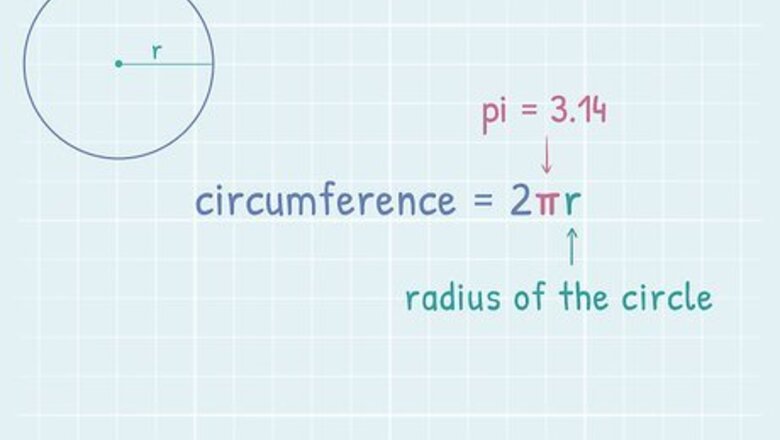
views
circumference
=
2
π
(
r
)
{\displaystyle {\text{circumference}}=2\pi (r)}
. Then you can use the formula
area
=
π
(
r
2
)
{\displaystyle {\text{area}}=\pi (r^{2})}
to find the area. You can also use the formula
circumference
=
2
π
(
A
)
{\displaystyle {\text{circumference}}=2{\sqrt {\pi (A)}}}
, which expresses the circumference of a circle as a function of its area, without knowing the length of the radius at all.
Finding the Radius Given the Circumference
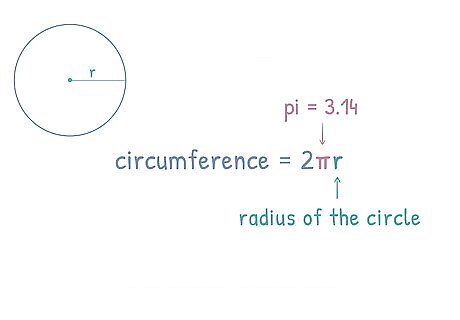
Set up the formula for finding the circumference of a circle. The formula is circumference = 2 π ( r ) {\displaystyle {\text{circumference}}=2\pi (r)} {\text{circumference}}=2\pi (r), where r {\displaystyle r} r equals the radius of the circle. Using this formula allows you to find the length of the radius, which can in turn be used to find the area of the circle.
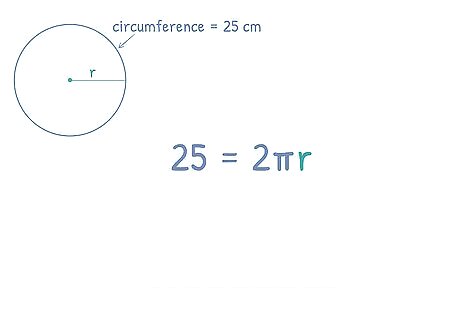
Plug the circumference into the formula. Make sure you substitute the value on the left side of the equation, not for the variable r {\displaystyle r} r. If you don’t know the circumference, you cannot use this method. For example, if you know the circumference of a circle is 25 centimeter (9.8 in), your formula will look like this: 25 = 2 π ( r ) {\displaystyle 25=2\pi (r)} 25=2\pi (r).
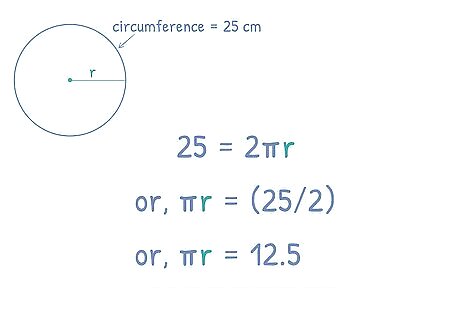
Divide both sides of the equation by 2. This will cancel the coefficient of 2 on the right side of the equation, leaving you with π ( r ) {\displaystyle \pi (r)} \pi (r). For example: 25 = 2 π ( r ) {\displaystyle 25=2\pi (r)} 25=2\pi (r) 25 2 = 2 π ( r ) 2 {\displaystyle {\frac {25}{2}}={\frac {2\pi (r)}{2}}} {\frac {25}{2}}={\frac {2\pi (r)}{2}} 12.5 = π ( r ) {\displaystyle 12.5=\pi (r)} 12.5=\pi (r)
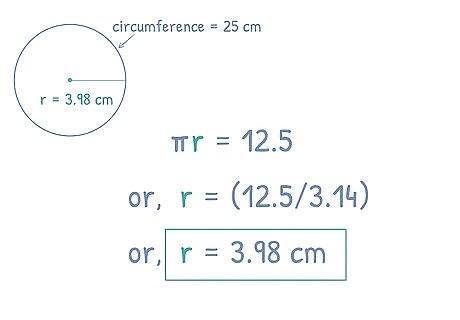
Divide both sides of the equation by 3.14. This is the generally accepted rounded value of π {\displaystyle \pi } \pi . You can also use the π {\displaystyle \pi } \pi function on a scientific calculator for a more exact result. Dividing by π {\displaystyle \pi } \pi isolates the radius, giving you its value. For example: 12.5 = π ( r ) {\displaystyle 12.5=\pi (r)} 12.5=\pi (r) 12.5 π = π ( r ) π {\displaystyle {\frac {12.5}{\pi }}={\frac {\pi (r)}{\pi }}} {\frac {12.5}{\pi }}={\frac {\pi (r)}{\pi }} 3.98 = r {\displaystyle 3.98=r} 3.98=r
Finding the Area Given the Radius
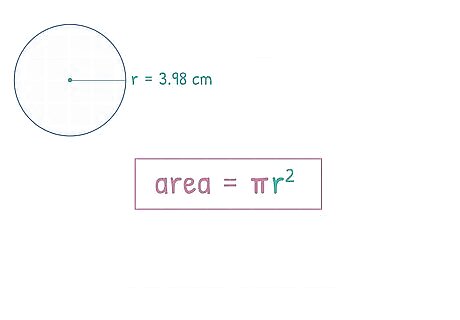
Set up the formula for finding the area of a circle. The formula is area = π ( r 2 ) {\displaystyle {\text{area}}=\pi (r^{2})} {\text{area}}=\pi (r^{{2}}), where r {\displaystyle r} r equals the radius of the circle. Don’t confuse the formula for area with the formula for circumference, which you previously used to calculate the radius.
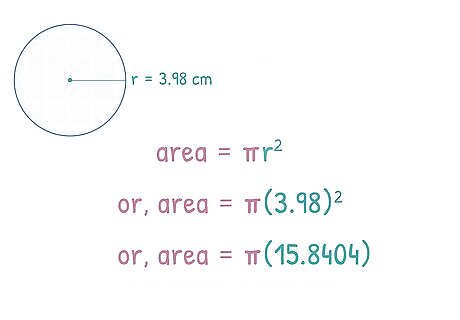
Plug the radius into the formula. Substitute the value you previously calculated and substitute it for the variable r {\displaystyle r} r. Then, square the value. To square a value means to multiply it by itself. It’s easy to do this using the x 2 {\displaystyle x^{2}} x^{{2}} button on a scientific calculator. For example, if you found the radius to be 3.98, you would calculate: area = π ( r 2 ) {\displaystyle {\text{area}}=\pi (r^{2})} {\text{area}}=\pi (r^{{2}}) area = π ( 3.98 2 ) {\displaystyle {\text{area}}=\pi (3.98^{2})} {\text{area}}=\pi (3.98^{{2}}) area = π ( 15.8404 ) {\displaystyle {\text{area}}=\pi (15.8404)} {\text{area}}=\pi (15.8404)
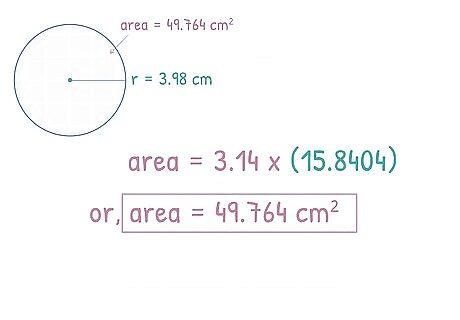
Multiply by π {\displaystyle \pi } \pi . If you are not using a calculator, you can use the rounded value 3.14 for π {\displaystyle \pi } \pi . The product will give you the area of the circle, in square units. For example: area = π ( 15.8404 ) {\displaystyle {\text{area}}=\pi (15.8404)} {\text{area}}=\pi (15.8404) area = 49.764 {\displaystyle {\text{area}}=49.764} {\displaystyle {\text{area}}=49.764}So, the area of a circle with a circumference of 25 centimeter (9.8 in) is about 49.764 square centimeters.
Using a Formula Given the Circumference

Set up the formula for the circumference of a circle, as a function of its area. The formula is circumference = 2 π ( A ) {\displaystyle {\text{circumference}}=2{\sqrt {\pi (A)}}} {\text{circumference}}=2{\sqrt {\pi (A)}}, where A {\displaystyle A} A equals the area of the circle. This formula is derived by rearranging the value of r {\displaystyle r} r in the formula for the area of a circle ( area = π ( r 2 ) {\displaystyle {\text{area}}=\pi (r^{2})} {\text{area}}=\pi (r^{{2}})) and substituting that value into the circumference formula ( circumference = 2 π ( r ) {\displaystyle {\text{circumference}}=2\pi (r)} {\text{circumference}}=2\pi (r)).

Plug the circumference into the formula. This information should be given to you. Make sure you substitute the circumference on the left side of the formula, not for the value of A {\displaystyle A} A on the right side. For example, if you know the circumference is 25 centimeter (9.8 in), your formula will look like this: 25 = 2 π ( A ) {\displaystyle 25=2{\sqrt {\pi (A)}}} 25=2{\sqrt {\pi (A)}}.
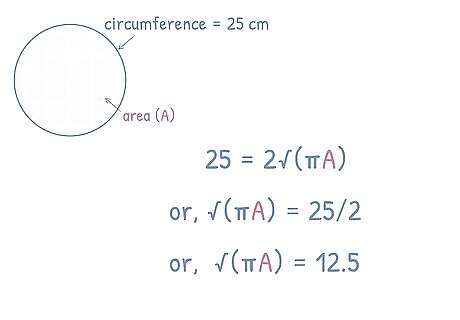
Divide both sides of the equation by 2. Remember that what you do to one side of an equation, you must do to the other side as well. Dividing by 2 simplifies the right side to π ( A ) {\displaystyle {\sqrt {\pi (A)}}} {\sqrt {\pi (A)}}. For example: 25 = 2 π ( A ) {\displaystyle 25=2{\sqrt {\pi (A)}}} 25=2{\sqrt {\pi (A)}} 25 2 = 2 π ( A ) 2 {\displaystyle {\frac {25}{2}}={\frac {2{\sqrt {\pi (A)}}}{2}}} {\frac {25}{2}}={\frac {2{\sqrt {\pi (A)}}}{2}} 12.5 = π ( A ) {\displaystyle 12.5={\sqrt {\pi (A)}}} 12.5={\sqrt {\pi (A)}}
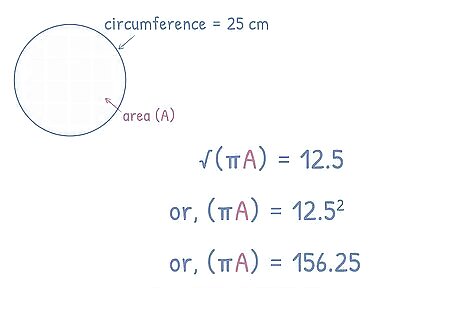
Square both sides of the equation. When you square a value, you multiply the value by itself. Squaring a square root cancels the square root, leaving you with the value under the radical sign. Remember to keep the equation balanced by squaring both sides. For example: 12.5 = π ( A ) {\displaystyle 12.5={\sqrt {\pi (A)}}} 12.5={\sqrt {\pi (A)}} 12.5 2 = ( π ( A ) ) 2 {\displaystyle 12.5^{2}=({\sqrt {\pi (A)}})^{2}} 12.5^{{2}}=({\sqrt {\pi (A)}})^{{2}} 156.25 = π ( A ) {\displaystyle 156.25=\pi (A)} 156.25=\pi (A)
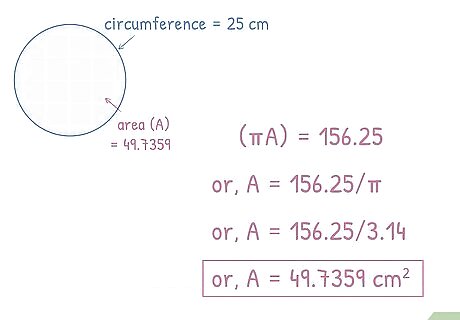
Divide each side of the equation by 3.14. If you have a scientific calculator, you can use the π {\displaystyle \pi } \pi function instead to get a more accurate answer. This will cancel out π {\displaystyle \pi } \pi on the right side of the equation, leaving you with the value of A {\displaystyle A} A. This is the area of the circle, in square units. For example: 156.25 = π ( A ) {\displaystyle 156.25=\pi (A)} 156.25=\pi (A) 156.25 π = π ( A ) π {\displaystyle {\frac {156.25}{\pi }}={\frac {\pi (A)}{\pi }}} {\frac {156.25}{\pi }}={\frac {\pi (A)}{\pi }} 49.7359 = A {\displaystyle 49.7359=A} 49.7359=ASo, the area of a circle with a circumference of 25 centimeter (9.8 in) is about 49.74 square centimeters.



















Comments
0 comment